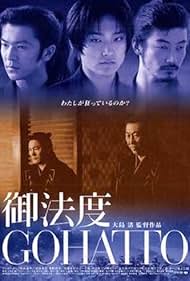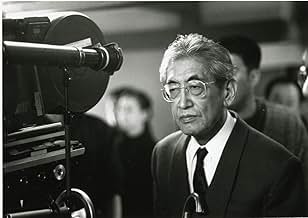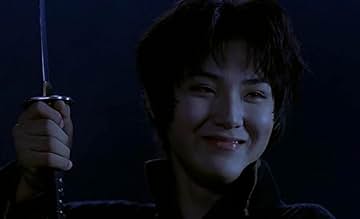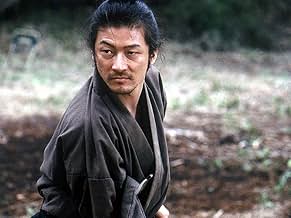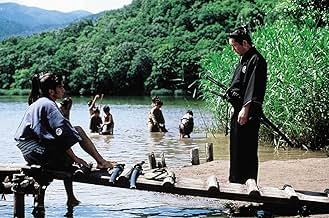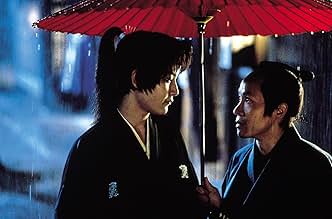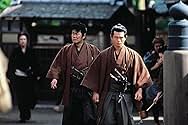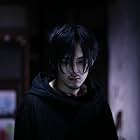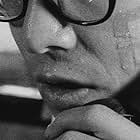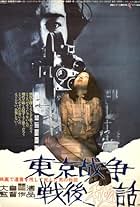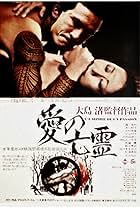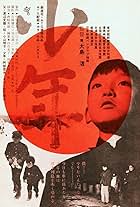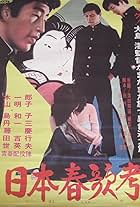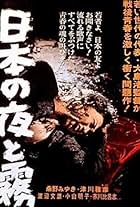VALUTAZIONE IMDb
6,8/10
8199
LA TUA VALUTAZIONE
Aggiungi una trama nella tua linguaThe new member of a samurai militia unit causes disruption as several of his colleagues fall in love with him, threatening to disturb the rigid code of their squad.The new member of a samurai militia unit causes disruption as several of his colleagues fall in love with him, threatening to disturb the rigid code of their squad.The new member of a samurai militia unit causes disruption as several of his colleagues fall in love with him, threatening to disturb the rigid code of their squad.
- Premi
- 10 vittorie e 11 candidature
Takeshi Kitano
- Captain Toshizo Hijikata
- (as 'Beat' Takeshi)
Trama
Lo sapevi?
- QuizThis was Nagisa Ôshima's only film after his 1996 stroke.
Recensione in evidenza
Oshima's first film in 14 years after illness was apparently directed from a wheel chair, and it's tempting to locate some of its static, formal qualities in the personal restrictions faced by the director. But this cool, intense, and very Japanese piece is stylistically rooted in the country's cinematic past, while at the same time offering provocative work familiar characteristic of this director. In his most famous film, Realm Of The Senses (aka: Ai No Corrida), made 25 years ago, dangerous sexual activity was explicit. In Gohatto (trans: Taboo), things are far less in the open. The expression of sex has been replaced with its obsession although, for Oshima, the irrationality of arousal still remains anti-authoritarian, as it creates impulses that are hard to resist.
For those more used to the straight samurai of old, Oshima's suggestions of cuddles beneath the kimono is a surprise (more outrage was generated in Japan, where it was felt more strongly that such suggestions ran against a proud tradition). One can never imagine stouthearted Toshiro Mifune, the most famous cinematic samurai from the previous generation, falling for another soldier and interrupting his role in Seven Samurai for a romp in the dojo. Cult actor/director 'Beat' Takeshi, here playing Captain Toshizo Hijikata, seems at first sight an odd choice for this sort of drama too, until one remembers the gay gunman he played so convincingly in Takashi Ishii's Gonin (1995). With his impassive face he reduces introspection to the reoccurring flicker of his (real life) tic, which, most aptly here, can suggest everything and nothing. Hijikata's internal narrative, first quizzical about Sozabura's lovers then perturbed about his effect on the garrison, suggests growing doubts resolved only in the final, memorable scene.
In Gohatto, much of the interest of the film lays in the degree in which Sozaburo's beauty arouses the interest of the men around him. Some are openly attracted to him (notably Tashiro, who shortly attempts to climb into the bed with him). Others are on the edge, like Inspector Yamazaki, charged with taking him to the brothel in Shimabara to introduce the youth to women. Most are affected in one way or another; most enigmatically are Hojikata and his superior and close colleague Commander Kondo (Yoichi Sai). As Hojikata observes, "a samurai can be undone by a love of men." But then he wonders too "Why are we both so indulgent with Sozabura?" and Kondo's rectitude and conspicuous silence hides, we suspect, a greater interest in the youth than he might wish to admit.
Oshima's visual scheme creates a film full of the bare, dark wood interiors of the militia base and the mud brown of uniforms, where just a few significant colours stand out. During the early beheading of the renegade samurai by Sozabuta, it is the red splash of the executed man's blood. At other times, Sozabuta wears a unique white robe (the Japanese colour of death). His is a presence and beauty shortly associated with a form of annihilation. In a place full of military men, that we see this feminine youth kill most often is no surprise. Compared to his contemporaries, he is the most adept at the sword unless fazed by romantic entanglements. It's an obvious irony that the object of homosexual affection is also the most deadly of the men; there's more in the fact that a group of iron-hearted soldiers can be so easily divided by an 'enemy' within, one neither fierce nor commanding.
There's another mystery in Gohatto, besides who exactly is sleeping with Sozabuta and who wants to. It's who is the murderer of Yuzawa (Tomorowo Taguchi), and doubts as to the truth of the case persist. This, and the attempt to apprehend the intruders at the base ("they call these samurai?") provide the main impetus of the plot. Like so many great Japanese films of the past, Oshima's says a lot in restraint. Here the arrangement of seated figures within the frame can suggest unspoken tensions, order is paramount, and the use of the camera is elegant and discreet. Some see the resulting style dull, when it is a slower, more contemplative way of seeing the world, one where not every question is answered.
What exactly is 'taboo' in Gohatto is clearly the issue of homosexuality - although confusingly for Western audiences such matters are not explicitly forbidden. Reference is made to the military code, which hangs on the barrack walls. Extracts appear on screen too, but no mention is made of prohibiting gay relations between soldiers. A man may be beheaded for illicitly borrowing money, but sleeping with his comrades at arms, while gossip worthy, is only really of concern when discipline is threatened. There "no secrets on Heaven and Earth (and) everyone knows it," says one of the intertitles, and Hojikata himself refers to the "tacit understanding" which normally keeps things in check. A policy which roughly equates to the modern American army's own "Don't ask, don't tell."
The film is helped immensely by Ryuichi Sakamoto's incessant, metronomic score, the steady beat of which considerably amplifies the obsessions and drawn out tensions of events. Like Oshima's interiors, it is uncluttered music, the muted colours dashed with an occasional significant tone. Now and again, urgency and violence break into this world: the initial beheading scene, the murderer's attacks, or the sword battle by the river. As a package, the result readily deserves art house admirers - especially as the director saves the best scene for last, expressing both Hojikata's final position, and a main thread of Gohatto, with hardly a cut more than necessary. Recommended.
For those more used to the straight samurai of old, Oshima's suggestions of cuddles beneath the kimono is a surprise (more outrage was generated in Japan, where it was felt more strongly that such suggestions ran against a proud tradition). One can never imagine stouthearted Toshiro Mifune, the most famous cinematic samurai from the previous generation, falling for another soldier and interrupting his role in Seven Samurai for a romp in the dojo. Cult actor/director 'Beat' Takeshi, here playing Captain Toshizo Hijikata, seems at first sight an odd choice for this sort of drama too, until one remembers the gay gunman he played so convincingly in Takashi Ishii's Gonin (1995). With his impassive face he reduces introspection to the reoccurring flicker of his (real life) tic, which, most aptly here, can suggest everything and nothing. Hijikata's internal narrative, first quizzical about Sozabura's lovers then perturbed about his effect on the garrison, suggests growing doubts resolved only in the final, memorable scene.
In Gohatto, much of the interest of the film lays in the degree in which Sozaburo's beauty arouses the interest of the men around him. Some are openly attracted to him (notably Tashiro, who shortly attempts to climb into the bed with him). Others are on the edge, like Inspector Yamazaki, charged with taking him to the brothel in Shimabara to introduce the youth to women. Most are affected in one way or another; most enigmatically are Hojikata and his superior and close colleague Commander Kondo (Yoichi Sai). As Hojikata observes, "a samurai can be undone by a love of men." But then he wonders too "Why are we both so indulgent with Sozabura?" and Kondo's rectitude and conspicuous silence hides, we suspect, a greater interest in the youth than he might wish to admit.
Oshima's visual scheme creates a film full of the bare, dark wood interiors of the militia base and the mud brown of uniforms, where just a few significant colours stand out. During the early beheading of the renegade samurai by Sozabuta, it is the red splash of the executed man's blood. At other times, Sozabuta wears a unique white robe (the Japanese colour of death). His is a presence and beauty shortly associated with a form of annihilation. In a place full of military men, that we see this feminine youth kill most often is no surprise. Compared to his contemporaries, he is the most adept at the sword unless fazed by romantic entanglements. It's an obvious irony that the object of homosexual affection is also the most deadly of the men; there's more in the fact that a group of iron-hearted soldiers can be so easily divided by an 'enemy' within, one neither fierce nor commanding.
There's another mystery in Gohatto, besides who exactly is sleeping with Sozabuta and who wants to. It's who is the murderer of Yuzawa (Tomorowo Taguchi), and doubts as to the truth of the case persist. This, and the attempt to apprehend the intruders at the base ("they call these samurai?") provide the main impetus of the plot. Like so many great Japanese films of the past, Oshima's says a lot in restraint. Here the arrangement of seated figures within the frame can suggest unspoken tensions, order is paramount, and the use of the camera is elegant and discreet. Some see the resulting style dull, when it is a slower, more contemplative way of seeing the world, one where not every question is answered.
What exactly is 'taboo' in Gohatto is clearly the issue of homosexuality - although confusingly for Western audiences such matters are not explicitly forbidden. Reference is made to the military code, which hangs on the barrack walls. Extracts appear on screen too, but no mention is made of prohibiting gay relations between soldiers. A man may be beheaded for illicitly borrowing money, but sleeping with his comrades at arms, while gossip worthy, is only really of concern when discipline is threatened. There "no secrets on Heaven and Earth (and) everyone knows it," says one of the intertitles, and Hojikata himself refers to the "tacit understanding" which normally keeps things in check. A policy which roughly equates to the modern American army's own "Don't ask, don't tell."
The film is helped immensely by Ryuichi Sakamoto's incessant, metronomic score, the steady beat of which considerably amplifies the obsessions and drawn out tensions of events. Like Oshima's interiors, it is uncluttered music, the muted colours dashed with an occasional significant tone. Now and again, urgency and violence break into this world: the initial beheading scene, the murderer's attacks, or the sword battle by the river. As a package, the result readily deserves art house admirers - especially as the director saves the best scene for last, expressing both Hojikata's final position, and a main thread of Gohatto, with hardly a cut more than necessary. Recommended.
- FilmFlaneur
- 24 ott 2006
- Permalink
I più visti
Accedi per valutare e creare un elenco di titoli salvati per ottenere consigli personalizzati
- How long is Taboo?Powered by Alexa
Dettagli
Botteghino
- Lordo Stati Uniti e Canada
- 114.425 USD
- Fine settimana di apertura Stati Uniti e Canada
- 9.947 USD
- 8 ott 2000
- Lordo in tutto il mondo
- 128.374 USD
- Tempo di esecuzione1 ora 40 minuti
- Colore
- Mix di suoni
- Proporzioni
- 1.85 : 1
Contribuisci a questa pagina
Suggerisci una modifica o aggiungi i contenuti mancanti

